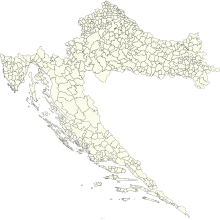Municipalities in Croatia (Croatian: općina; plural: općine) are the second-lowest administrative unit of government in the country, and along with cities and towns (grad, plural: gradovi) they form the second level of administrative subdisivion, after counties. Each municipality consists of one or more settlements (naselja) , which are the third-level spatial units of Croatia.[1][2][3]

Though equal in powers and administrative bodies, municipalities and towns differ in that municipalities are usually more likely to consist of a collection of villages in rural or suburban areas, whereas towns are more likely to cover urbanised areas. Croatian law defines municipalities as local self-government units which are established, in an area where several inhabited settlements represent a natural, economic and social entity, related to one other by the common interests of the area's population.[4]
As of 2023, the 21 counties of Croatia are subdivided into 128 towns and 428 municipalities, which in turn are subdivided into 6757 settlements.[5][6][1]
Tasks and organization
editMunicipalities, within their self-governing scope of activities, perform the tasks of local significance, which directly fulfil the citizens’ needs, and which were not assigned to the state bodies by the constitution or law, and in particular affairs related to the organization of localities and housing, zoning and planning, public utilities, child care, social welfare, primary health services, education and primary schools, culture, physical education and sports, customer protection, protection and improvement of the environment, fire protection and civil defence, and local transport.[4][7]
Municipality government
editMunicipal council (općinsko vijeće) is the representative body of citizens and the body of local self-government. The councillors are elected for a four-year term on the basis of universal suffrage in direct elections by secret ballot using proportional system with the D'Hondt method. The executive head of the municipality is the municipality president (općinski načelnik), also elected in direct elections for a four-year term, by majority vote (two-round system) (the deputy president is elected together with the president). They (with the deputy president) can be recalled by a referendum. Municipalities have administrative departments as offices of municipal administration (in small municipalities there is unique administrative department) chaired by the heads (principals). They are appointed by the municipal president on the basis of a public competition.[4][8]
Croatian municipalities are administratively subdivided into "local committee areas" (mjesni odbori) with elected councils.
List of municipalities
editAs of 2015[update], there are 428 municipalities in Croatia.[9]
Continental Croatia
editKoprivnica-Križevci County
editKrapina-Zagorje County
edit- Bedekovčina
- Budinščina
- Desinić
- Đurmanec
- Gornja Stubica
- Hrašćina
- Hum na Sutli
- Jesenje
- Kraljevec na Sutli
- Krapinske Toplice
- Konjščina
- Kumrovec
- Lobor
- Marija Bistrica
- Mače
- Mihovljan
- Novi Golubovec
- Petrovsko
- Radoboj
- Sveti Križ Začretje
- Stubičke Toplice
- Tuhelj
- Veliko Trgovišće
- Zagorska Sela
- Zlatar-Bistrica
Međimurje County
editVaraždin County
editZagreb County
editBjelovar-Bilogora County
editBrod-Posavina County
editKarlovac County
editOsijek-Baranja County
edit- Antunovac
- Bilje
- Bizovac
- Čeminac
- Čepin
- Darda
- Donja Motičina
- Draž
- Drenje
- Đurđenovac
- Erdut
- Ernestinovo
- Feričanci
- Gorjani
- Jagodnjak
- Kneževi Vinogradi
- Koška
- Levanjska Varoš
- Magadenovac
- Marijanci
- Petlovac
- Petrijevci
- Podravska Moslavina
- Podgorač
- Popovac
- Punitovci
- Satnica Đakovačka
- Semeljci
- Strizivojna
- Šodolovci
- Trnava
- Viljevo
- Viškovci
- Vladislavci
- Vuka
Požega-Slavonia County
editSisak-Moslavina County
editVirovitica-Podravina County
editVukovar-Srijem County
editAdriatic Croatia
editDubrovnik-Neretva County
editIstria County
editLika-Senj County
editPrimorje-Gorski Kotar County
editŠibenik-Knin County
editSplit-Dalmatia County
edit- Baška Voda
- Bol
- Brela
- Cista Provo
- Dicmo
- Dugi Rat
- Dugopolje
- Gradac
- Hrvace
- Jelsa
- Klis
- Lećevica
- Lokvičići
- Lovreć
- Marina
- Milna
- Muć
- Nerežišća
- Okrug
- Otok Dalmatinski
- Podbablje
- Podgora
- Podstrana
- Postira
- Prgomet
- Primorski Dolac
- Proložac
- Pučišća
- Runovići
- Seget
- Selca
- Sućuraj
- Sutivan
- Šestanovac
- Šolta
- Tučepi
- Zadvarje
- Zagvozd
- Zmijavci
Zadar County
editSee also
editReferences
edit- ^ a b Register of spatial units of the State Geodetic Administration of the Republic of Croatia. Wikidata Q119585703.
- ^ "Zakon o područjima županija, gradova i općina u Republici Hrvatskoj". Narodne novine (in Croatian). Retrieved 2023-10-02.
- ^ "Zakon o naseljima". www.zakon.hr (in Croatian). Retrieved 2023-10-02.
- ^ a b c "Zakon o lokalnoj i područnoj (regionalnoj) samoupravi (pročišćeni tekst)" [Local and Regional Self-Government Act (consolidated text)]. Narodne novine (in Croatian). No. 19/2013. 18 February 2013. Retrieved 1 October 2016.
- ^ "Zakon o područjima županija, gradova i općina u Republici Hrvatskoj" [Territories of Counties, Cities and Municipalities of the Republic of Croatia Act]. Narodne novine (in Croatian). 28 July 2006. Retrieved 9 September 2011.
- ^ "Popovača dobila status grada". Poslovni dnevnik (in Croatian). 12 April 2013. Retrieved 27 January 2014.
- ^ The Constitution of the Republic of Croatia (consolidated text) - Croatian Parliament Archived 2015-11-02 at the Wayback Machine.Retrieved October 1, 2016.
- ^ "Zakon o lokalnim izborima" [Local Elections Act]. Narodne novine (in Croatian). No. 144/2012. 21 December 2012. Retrieved 1 October 2016.
- ^ "Popis gradova i općina" (Microsoft Excel). uprava.hr (in Croatian). Ministry of Public Administration, Croatia. 10 June 2013. Retrieved 2 December 2015.